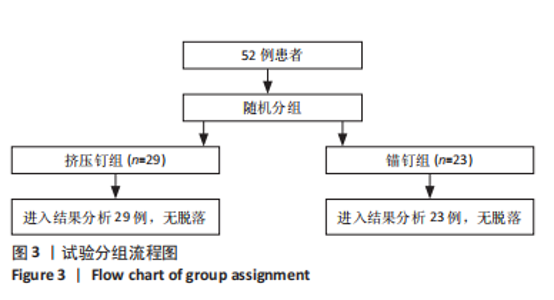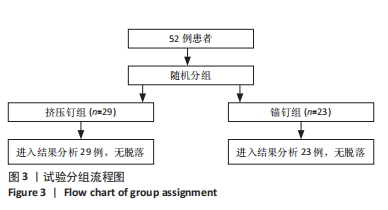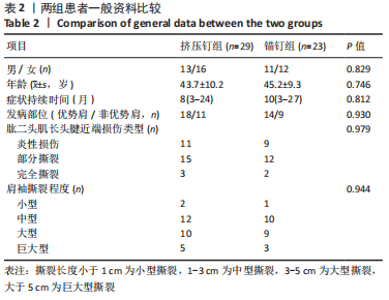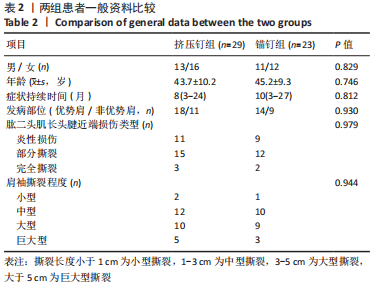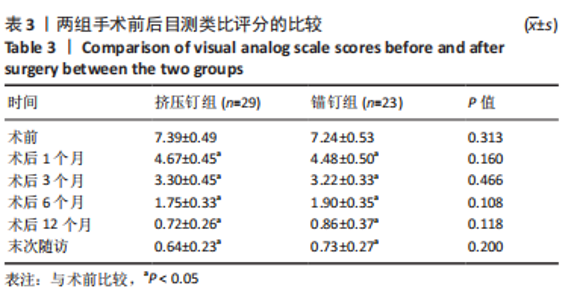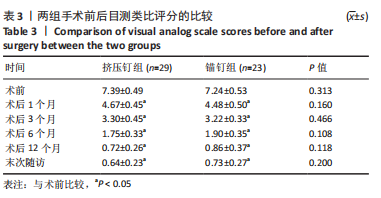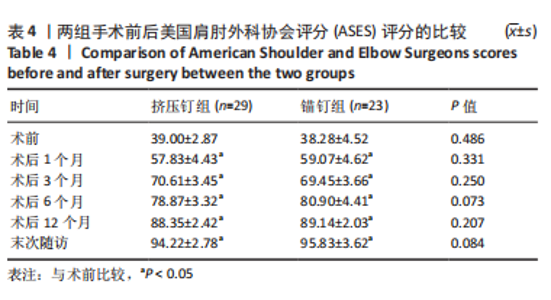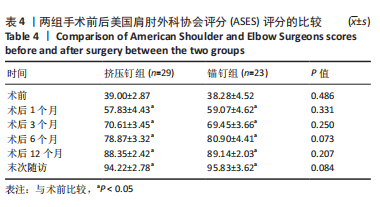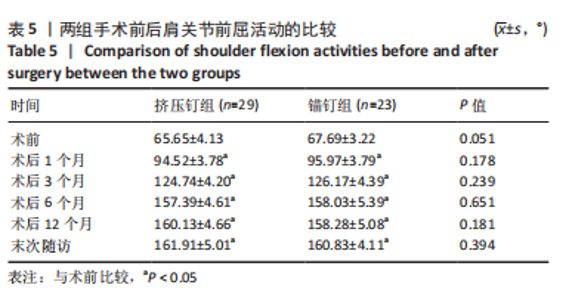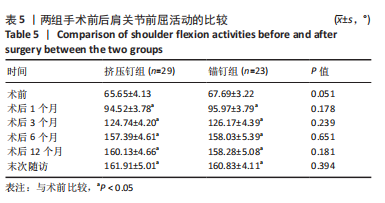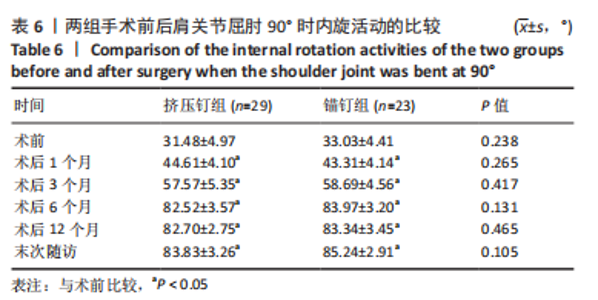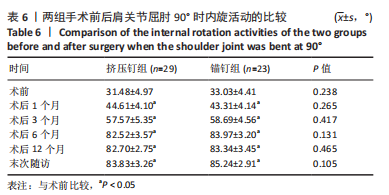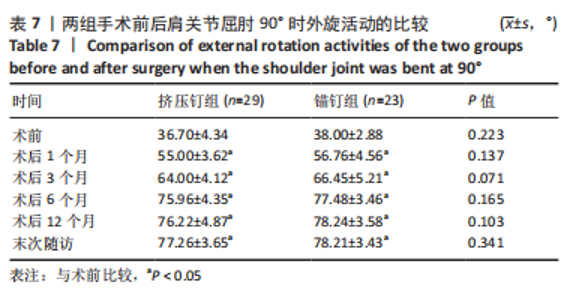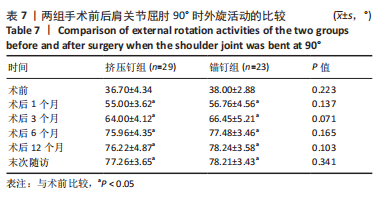Chinese Journal of Tissue Engineering Research ›› 2023, Vol. 27 ›› Issue (28): 4533-4538.doi: 10.12307/2023.696
Previous Articles Next Articles
Comparison of two kinds of tendon fixation in arthroscopy for treating proximal lesions of long head of biceps tendons
Gong Li, Zhou Ming, Fan Shaoyong, Hou Huiming, Zou Wen, Hu Liangshen
- Nanchang Hongdu Hospital of TCM, Nanchang 330008, Jiangxi Province, China
-
Received:2022-08-19Accepted:2022-10-24Online:2023-10-08Published:2023-01-29 -
Contact:Zhou Ming, Master, Associate chief physician, Master’s supervisor, Nanchang Hongdu Hospital of TCM, Nanchang 330008, Jiangxi Province, China -
About author:Gong Li, Master, Physician, Nanchang Hongdu Hospital of TCM, Nanchang 330008, Jiangxi Province, China -
Supported by:shoulder arthroscopy| long head of biceps tendons| rotator cuff tear| interface extrusion screw| suture anchor| internal fixation
CLC Number:
Cite this article
Gong Li, Zhou Ming, Fan Shaoyong, Hou Huiming, Zou Wen, Hu Liangshen. Comparison of two kinds of tendon fixation in arthroscopy for treating proximal lesions of long head of biceps tendons[J]. Chinese Journal of Tissue Engineering Research, 2023, 27(28): 4533-4538.
share this article
Add to citation manager EndNote|Reference Manager|ProCite|BibTeX|RefWorks
| [1] ATAOGLU MB, CETINKAYA M, OZER M, et al. The high frequency of superior labrum, biceps tendon, and superior rotator cuff pathologies in patients with subscapularis tears: a cohort study. J Orthop Sci. 2018; 23(2):304-309. [2] KHAZZAM M, GEORGE MS, CHURCHILL RS, et al. Disorders of the long head of biceps tendon. J Shoulder Elbow Surg. 2012;21(1):136-145. [3] VESTERMARK GL, VANDOREN BA, CONNOR PM, et al. The prevalence of rotator cuff pathology in the setting of acute proximal biceps tendon rupture. J Shoulder Elbow Surg. 2018;27(2):1258-1262. [4] MACDONALD P, VERHULST F, MCRAE S, et al. Biceps tenodesis versus tenotomy in the treatment of lesions of the long head of the biceps tendon in patients undergoing arthroscopic shoulder surgery: a prospective double-blinded randomized controlled trial. Am J Sports Med. 2020;48(6):1439-1449. [5] GALDI B, SOUTHREN DL, BRABSTON EW, et al. Patients Have Strong Preferences and Perceptions for Biceps Tenotomy Versus Tenodesis. Arthroscopy. 2016;32:2444-2450. [6] WITTSTEIN JR, QUEEN R, ABBEY A, et al. Isokinetic strength, endurance, and subjective outcomes after biceps tenotomy versus tenodesis: a postoperative study. Am J Sports Med. 2011;39(4):857-865. [7] 易刚,杨静,张磊,等.肌腱切断和肌腱固定修复伴肩袖损伤肱二头肌长头腱病变疗效比较的Meta分析[J].中国组织工程研究,2018, 22(24):3921-3929. [8] VAJDA M, SZAKó L, HEGYI P, et al. Tenodesis yields better functional results than tenotomy in long head of the biceps tendon operations-a systematic review and meta-analysis. Int Orthop. 2022;46(5):1037-1051. [9] ZHOU P, LIU J, DENG X, et al. Biceps tenotomy versus tenodesis for lesions of the long head of the biceps tendon:A systematic review and meta-analysis of randomized controlled trials. Medicine (Baltimore). 2021;100(3):e23993. [10] PANICOL L, ROY T, NAMDARI S. Long Head of the Biceps Tendon Ruptures: Biomechanics,Clinical Ramifications, and Management. JBJS Rev. 2021;9(10):e21. [11] POGORZELSKI J, HORAN MP, HUSSAIN ZB, et al. Subpectoral biceps tenodesis for treatment of isolated type II SLAP lesions in a young and active population. Arthroscopy. 2018;34(2):371-376. [12] GRIFFIN JW, CVETANOVICH GL, KIM J, et al. Biceps tenodesis is a viable option for management of proximal biceps injuries in patients less than 25 years of age. Arthroscopy. 2019;35(4):1036-1041. [13] MCCRUM CL, ALLURI RK, BATECH M, et al. Complications of biceps tenodesis based on location, fixation, and indication: A review of 1526 shoulders. J Shoulder Elbow Surg. 2019;28(3):461-469. [14] 向先祥,刘宇鹏,陈荣进,等.关节镜下结节间沟固定与小切口胸大肌止点下固定治疗肱二头肌长头腱腱病的疗效比较[J].中国修复重建外科杂志,2021,35(10):1293-1297. [15] PATZER T, SANTO G, OLENDER GD, et al. Suprapectoral or subpectoral position for biceps tenodesis: Biomechanical comparison of four different techniques in both positions. Shoulder and Elbow Surg. 2011;21(1):116-125. [16] SSASKI Y, OCHIAI N, KENMOKU T, et al. Arthroscopic tenodesis using a bioabsorbable interference screw and soft anchor: A case series of 60 patients. J Shoulder Elbow Surg. 2020;25(3):410-415. [17] ITOI E, KUECHLE DK, NEWMAN SR, et al. Stabilising function of the biceps in stable and unstable shoulders. J Bone Joint Surg Br. 1993; 75:546-550. [18] PAGNANI MJ, DENG XH, WARREN RF, et al. Role of thelong head of the biceps brachii in glenohumeral stability: a biomechanical study in cadavera. J Shoulder Elbow Surg. 1996;5(4):255-262. [19] RAUCK RC, JAHANDAR A, KONTAXIS A, et al. The role of the long head of the biceps tendon in posterior shoulder stabilization during forward flexion. J Shoulder Elbow Surg. 2022;31(6):1254-1260. [20] LALEHZARIAN SP, AGARWALLA A, LIU JN. Management of proximal biceps tendon pathology. World J Orthop. 2022;13:36-57. [21] 陈礼阳,易诚青.肱二头肌长头腱滑车结构损伤的特点及研究进展[J].中华肩肘外科电子杂志,2021,9(3):281-283. [22] CIVAN O, BILSELl K, KAPICIOGLU M, et al. Repair versus biceps tenodesis for the slap tears: A systematic review. J Orthop Surg (Hong Kong). 2021;29:23094990211004794. [23] ALDON-VILLEGAS R, PEREZ-CABEZAS V, CHAMORRO-MORIANA G. Efficacy of management of associated dysfunctions on rotator cuff and long head of the biceps: systematic review. J Orthop Surg Res. 2021;16: 501. [24] GODENECHE A, NOVE-JOSSERAND L, AUDEBERT S,et al. Relationship between subscapularis tears and injuries to the biceps pulley. Knee Surg Sports Traumatol Arthrosc. 2017;(7):2114-2120. [25] ULUCAKOY C, KAPTAN AY, YAPAR A, et al. The effect of bicipital groove morphology on the stability of the biceps long head tendon. Arch Orthop Trauma Surg. 2021;141:1325-1330. [26] CANDELA V, PREZIOSI SJ, CARBONE S, et al. Shoulder Long Head Biceps Tendon Pathology Is Associated With Increasing Rotator Cuff Tear Size. Arthrosc Sports Med Rehabil. 2021;3(5):e1517-e1523. [27] KAO JT, CHIU CH, HSU KY, et al. Arthroscopic diagnosis of long head of biceps tendon instability in refractory anterior shoulder pain:A comparison study between pulley tear and non-tear lesions.Biomed J. 2022;19:S2319-4170(22)00003-8. [28] 李敏,SHAIKH ATIK BADSHAH,彭赓,等.合并肩袖损伤的肱二头肌长头腱病变固定与切断比较[J]. 中国矫形外科杂志,2021,29(24): 2272-2274. [29] DESAI SS, MATA HK. Long Head of Biceps Tendon Pathology and Results of Tenotomy in Full-Thickness Reparable Rotator Cuff Tear. Arthroscopy. 2017;33(11):1971-1976. [30] AHMED AF, TOUBASI A, MAHMOUD S, et al. Long head of biceps tenotomy versus tenodesis: a systematic review and meta-analysis of randomized controlled trials. Shoulder Elbow. 2021;13(6): 583-591. [31] BELAY ES, WITTSTEIN JR, GARRIGUES GE, et al. Biceps tenotomy has earlier pain relief compared to biceps tenodesis: a randomized prospective study. Knee Surg Sports Traumatol Arthrosc. 2019;27(12): 4032-4037. [32] VERMA N. In Adults with Lesions of the Long Head of the Biceps Tendon, Tenodesis and Tenotomy Did Not Differ for Pain and Function at 2 Years. J Bone Joint Surg Am. 2021;103(4):357. [33] AFLATOONI JO, MEEKS BD, FROEHLE AW, et al. Biceps tenotomy versus tenodesis: patient-reported outcomes and satisfaction. J Orthop Surg Res. 2020;15(1):56. [34] MAZZOCCA AD, BURTON KJ, ROMEO AA, et al. Biomechanical evaluation of 4 techniques of distal biceps brachii tendon repair. Am J Sports Med. 2007;35(2):252-258. [35] SAMPATACOS N, GRTELMAN MH, HENNINGER HB. Biomechanical comparison of two techniques for arthroscopic suprapectoral biceps tenodesis:interference screw versus implant-free intraosseous tendon fixation.J Shoulder Elbow Surg. 2014;23:1731-1739. [36] RAMOS CH, C0ELHO JC. Biomechanical evaluation of the long head of the biceps brachii tendon fixed by three techniques:a sheep model. Rev Bras Ortop. 2016;52(1):52-60. |
| [1] | Zheng Bo, Zhang Xiuli, Zhou Hao, He Zebi, Zhou Jin, Zhou Weiyun, Li Peng. Arthroscopy-assisted locking hollow screw fixation and open reduction plate internal fixation in the treatment of Schatzker II-III tibial plateau fractures: early CT evaluation [J]. Chinese Journal of Tissue Engineering Research, 2023, 27(9): 1410-1416. |
| [2] | Chen Lei, Jia Yanfei, Lyu Huicheng, Zhang Lifeng. Application of T-shaped plate for fractures involving the quadrilateral region of acetabulum [J]. Chinese Journal of Tissue Engineering Research, 2023, 27(4): 578-582. |
| [3] | Hong Xiao, Luo Hong, Yang Ruonan. Comparison of dynamic hip screw and anti-rotation screw internal fixation and femoral neck system internal fixation in the treatment of Garden II-IV femoral neck fracture [J]. Chinese Journal of Tissue Engineering Research, 2023, 27(4): 583-587. |
| [4] | Bao Kai, Song Wenhui, Liu Changwen, Liang Kaiheng, Wang Jiajia. Posterior single-segment pedicle screw fixation for unstable atlas fractures [J]. Chinese Journal of Tissue Engineering Research, 2023, 27(4): 594-599. |
| [5] | Yin Hao, Chen Guang, Li Yan, Zhou Enchang, Ning Rende. Finite element analysis of dorsal Kirschner wire for enhancing the stability of the dorsal ulnar fracture fragment in AO C type distal radial fractures [J]. Chinese Journal of Tissue Engineering Research, 2023, 27(31): 4921-4925. |
| [6] | Shen Yong, Liu Shizhang, Zhai Tengfei, Hou Shuanghu, Feng Min. Correlation of acromial index and acromiohumeral distance with age in middle-aged and elderly patients with degenerative rotator cuff tear [J]. Chinese Journal of Tissue Engineering Research, 2023, 27(31): 5040-5045. |
| [7] | Zhan Yi, Wang Biao, Ma Yuli, He Simin, Sun Honghui, Hao Dingjun. Biomechanical comparison between a novel bone cement screw system and common surgical methods for the treatment of Kummell’s disease [J]. Chinese Journal of Tissue Engineering Research, 2023, 27(3): 385-390. |
| [8] | Liu Xiuqi, Chen Fang, Zhong Hehe, Xiong Huazhang, Lyu Guoqing, Wu Shuhong, Liu Yi. Short-term follow-up of modified elastic fixation Latarjet procedure for recurrent anterior dislocation of shoulder with obvious glenoid bone defect [J]. Chinese Journal of Tissue Engineering Research, 2023, 27(29): 4684-4689. |
| [9] | Alimu·Keremu, Liang Zhilin, Pazila·Aila, Maimaitiaili·Abulikemu, Aikebaier·Tuxun. Application of multi-slice spiral CT combined with 3D printing in the treatment of rotationally unstable pelvic fractures [J]. Chinese Journal of Tissue Engineering Research, 2023, 27(27): 4345-4350. |
| [10] | Yin Wei, Ouyang Zhen, Zhou Juan, Yang Binhui, Wei Yongkun. Finite element analysis of different internal fixation methods for Delbet II type femoral neck fracture in children [J]. Chinese Journal of Tissue Engineering Research, 2023, 27(22): 3476-3480. |
| [11] | Gu Ye, Wang Qiufei, Fang Tao, Peng Yuqin, Xue Feng, Geng Dechun, Xu Yaozeng, Zhang Wen. Biomechanical analysis of femoral neck system in unstable femoral neck fractures [J]. Chinese Journal of Tissue Engineering Research, 2023, 27(22): 3481-3485. |
| [12] | Liu Tao, Zha Mingjian, Ke Rongjun. Comparison of the third generation multiloc intramedullary nail, common curved intramedullary nail and proximal humeral locking plate in the treatment of complex proximal humeral fractures [J]. Chinese Journal of Tissue Engineering Research, 2023, 27(22): 3537-3543. |
| [13] | Liu Xu, Chen Hao, Kong Xiangru, Jiang Wei. Insertion of distal interlocking of femoral intramedullary nails with vernier device [J]. Chinese Journal of Tissue Engineering Research, 2023, 27(18): 2866-2870. |
| [14] | Bai Xiaosong, Gao Liying, Zhang Dingding, Liu Wenlong, Zhang Tao, Shen Xiaoyang, Liang Chunyu, Sun Xiaoxin. Full-thickness rotator cuff tear repair by injection of leukocyte-poor platelet-rich plasma: a comparison of low and high concentration groups [J]. Chinese Journal of Tissue Engineering Research, 2023, 27(16): 2467-2472. |
| [15] | Xiang Shijun, Sun Qiang, Su Yun, Dong Xinli, Jiang Jian. Three-dimensional finite element analysis of the treatment of ulnar coronoid process fracture with modified threaded Kirschner wire [J]. Chinese Journal of Tissue Engineering Research, 2023, 27(13): 2016-2021. |
| Viewed | ||||||
|
Full text |
|
|||||
|
Abstract |
|
|||||
